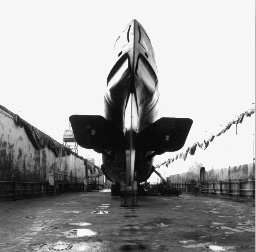USS PAMPANITO (SS-383)THE FIRST DRY DOCKING - 1987 In
1987 there were three commercial shipyards in San Francisco and all of
them responded with bids. The three bids were very close so we chose the
yard that we felt that would do the best job, not the lowest bidder. The
chosen bid did not, however, include work that had to be surveyed once
the vessel was in dry dock. To address the potential problem of wasted
weld seams, for example, a price per foot to renew wasted seams was quoted
in each bid. In
1987 there were three commercial shipyards in San Francisco and all of
them responded with bids. The three bids were very close so we chose the
yard that we felt that would do the best job, not the lowest bidder. The
chosen bid did not, however, include work that had to be surveyed once
the vessel was in dry dock. To address the potential problem of wasted
weld seams, for example, a price per foot to renew wasted seams was quoted
in each bid.
Pampanito left for the shipyard in February, 1987. It had taken us five years to arrive at a plan of action and to accumulate the funds necessary execute it. We knew that there would be additional work to be done in the shipyard and we had funding available to go over the bid amount by about forty percent. Once Pampanito was up on the blocks and the marine growth was removed, a survey was conducted to determine the extent of the additional work to be performed. It was found that some of the problems we thought would be extensive were not as bad as had been anticipated. There were virtually no wasted weld seams, less than twenty linear feet, and the underwater body was in very good condition. The submerged portions of the superstructure were just as we had thought and repairs were needed. However, we found some problems we had not anticipated. The screws had been removed and the protective covers placed on the shaft tapers had deteriorated, our off shore mooring system was chaffing the hull and the free flooding chain locker had a few tons of mud that had accumulated when the flood ports at the bottom were blanked off. The additional work was estimated and we were still within the resources of our hull fund and the additional work was authorized. We also took the opportunity while Pampanito was in dry dock to plan for future work that would need to be done in subsequent shipyard visits. Several critical areas were identified that would be monitored to evaluate the measures we were taking. Association staff took advantage of the time to have the submarine all to themselves and carried out several projects that could not be worked on while the vessel was open to the public. Extensive documentation, in the form of written reports, photographs and video tape, was done during the shipyard period. Shift-by-shift work reports were kept in a log that contained a description of the work accomplished, the weather conditions, materials used and a record of the shipyard work force. An added unexpected benefit of the video taping was that while the shipyard workers were being taped they were proud to display their best work. The shipyard period went very well. The job had come in on time and on budget, and we had a much clearer idea of Pampanito's condition and what her future needs would be.
|
